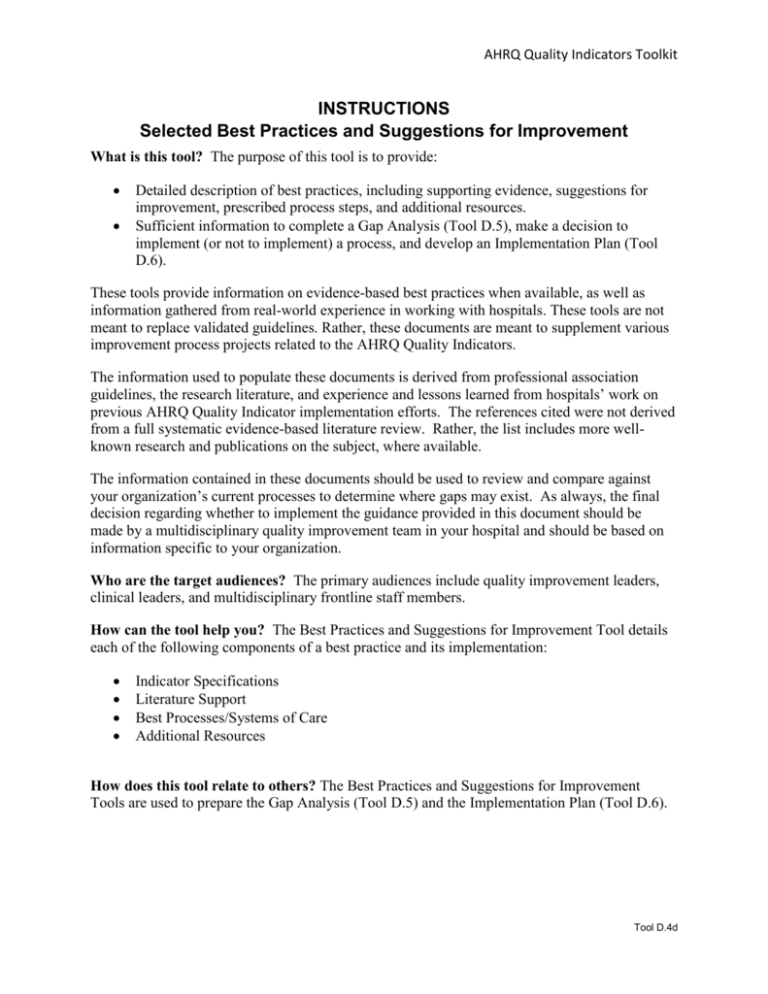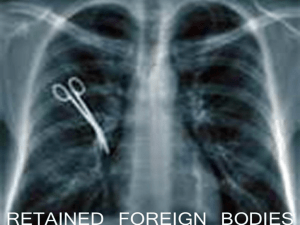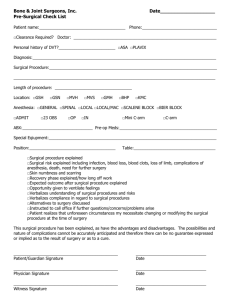d4d-foreignbody-bestpractices
advertisement

AHRQ Quality Indicators Toolkit INSTRUCTIONS Selected Best Practices and Suggestions for Improvement What is this tool? The purpose of this tool is to provide: Detailed description of best practices, including supporting evidence, suggestions for improvement, prescribed process steps, and additional resources. Sufficient information to complete a Gap Analysis (Tool D.5), make a decision to implement (or not to implement) a process, and develop an Implementation Plan (Tool D.6). These tools provide information on evidence-based best practices when available, as well as information gathered from real-world experience in working with hospitals. These tools are not meant to replace validated guidelines. Rather, these documents are meant to supplement various improvement process projects related to the AHRQ Quality Indicators. The information used to populate these documents is derived from professional association guidelines, the research literature, and experience and lessons learned from hospitals’ work on previous AHRQ Quality Indicator implementation efforts. The references cited were not derived from a full systematic evidence-based literature review. Rather, the list includes more wellknown research and publications on the subject, where available. The information contained in these documents should be used to review and compare against your organization’s current processes to determine where gaps may exist. As always, the final decision regarding whether to implement the guidance provided in this document should be made by a multidisciplinary quality improvement team in your hospital and should be based on information specific to your organization. Who are the target audiences? The primary audiences include quality improvement leaders, clinical leaders, and multidisciplinary frontline staff members. How can the tool help you? The Best Practices and Suggestions for Improvement Tool details each of the following components of a best practice and its implementation: Indicator Specifications Literature Support Best Processes/Systems of Care Additional Resources How does this tool relate to others? The Best Practices and Suggestions for Improvement Tools are used to prepare the Gap Analysis (Tool D.5) and the Implementation Plan (Tool D.6). Tool D.4d AHRQ Quality Indicators Toolkit Instruction Steps 1. See instructions for Gap Analysis (Tool D.5). 2. Use the appropriate Selected Best Practices and Suggestions for Improvement Tool to populate the Gap Analysis (Tool D.5). 2 Tool D.4d AHRQ Quality Indicators Toolkit Selected Best Practices and Suggestions for Improvement Patient Safety Indicator Specifications PSI 5: Foreign Body Left in During Procedure Numerator: Discharges 18 years and older or major diagnostic category (MDC) 14 (Pregnancy, Childbirth, and Puerperium), with International Classification of Diseases (ICD)-9 codes for foreign body left in during procedure in any secondary diagnosis field of medical and surgical discharges defined by specific diagnosis-related groups (DRGs) or Medicare Severity (MS)-DRGs. Denominator: Not applicable. Exclude: ICD-9 codes for foreign body left in during procedure in the principal diagnosis field or secondary diagnosis present on admission. Missing gender (SEX=missing), age (AGE=missing), quarter (DQTR=missing), year (YEAR=missing), or principal diagnosis (DX1=missing). Reference: AHRQ Patient Safety Indicators Technical Specifications, Version 4.3, August 2011. Recommended Practice Details of Recommended Practice Counts at Appropriate Points During Surgery Perform a sponge, sharp, and instrument count when instruments/sponges are opened, as surgery begins, as closure begins, and during subcuticular or skin closure in the same sequence.2–5,8,11,14 Appropriate Staff Education Create an education model that promotes development of knowledge and research for perioperative staff consistent with national criteria.7 Team Collaboration Promote and maintain a collaborative and ethical work environment that facilitates trust and confidence to allow all members of the interdisciplinary team the opportunity to speak up if patient safety is compromised.7,9,10 Integrate new instruments or equipment into practice that prevents retention of foreign bodies, including incorporating modern technology as a safety practice.6,7,12–14 Use of Equipment and Instruments Standardized Practices Integrate use of innovative surgical techniques, radiographic technology, and standardized practices and protocols for all procedures.2,3,8 Literature Support Counts at Appropriate Points During Surgery “The surgical count is fundamental; its purpose is two-fold: to ensure that items such as surgical instruments, sponges and sutures are not retained in the patients’ surgical wounds, and to ensure that instruments are not accidentally discarded with rubbish and drapes at the end of the procedure, necessitating replacement. ” Riley R, Manias E, Polgase A. Governing the surgical count through communication interactions: implications for patient safety. Qual Saf Health Care 2006;15:369–74. 3 Tool D.4d AHRQ Quality Indicators Toolkit “We strongly recommend that hospitals actively monitor compliance with the existing standard of counting sponges in every operation, including obstetrical procedures, and of counting instruments in every operation involving an open cavity.” Gawande AA, Studdert DM, Orav EJ, et al. Risk factors for retained instruments and sponges after surgery. N Engl J Med 2003;348:229–35. Appropriate Staff Education “The most important component of safe surgery is human resources. Perioperative nurses are the key personnel who work in conjunction with the surgical team to achieve patient safety.” “Safety policy promotion and education for the surgical care team may help to achieve patient safety goals and decrease surgical adverse events.” Kasatpibal N. Safe surgery implementation in Thailand. AORN J 2009;90(5):743–49. “Staff should review the recommended standards for counting. Educational programs should be provided that emphasize the importance of the count procedure.” Independent Study Guide: Prevention of retained sponges and towels following surgery. Dublin, OH: Cardinal Health; 2008. Available: at http://www.cardinal.com/education/documents/pdf/CEPrevention%20of%20Retained%20Sponges%20and%20Towels.pdf. Accessed September 19, 2011. Team Collaboration “The key to safe surgery is a multidisciplinary approach.” Kasatpibal N. Safe surgery implementation in Thailand. AORN J 2009;90(5):743–49. “All members of the perioperative team must take responsibility for minimizing the human factors that can contribute to errors in the counting process. The result can be an inaccurate count and a retained foreign body.” “Efforts should be made to enhance communication among surgical team members.” Independent Study Guide. Prevention of retained sponges and towels following surgery. Dublin, OH: Cardinal Health; 2008. Available at: http://www.cardinal.com/education/documents/pdf/CEPrevention%20of%20Retained%20Sponges%20and%20Towels.pdf. Accessed September 19, 2011. “There seems little doubt that improving the communication skills among nurses, and between surgeons and nurses, will assist in dealing with patient safety to safeguard against the possibility of retained surgical items.” Riley R, Manias E, Polgase A. Governing the surgical count through communication interactions: implications for patient safety. Qual Saf Health Care 2006;15:369–74. Use of Equipment and Instruments “Use only X-ray detectable sponges and towels during surgical procedures.” Fayngersh Y. Is your count correct? OR Nurse 2011;5(2):48. “Our findings imply that routine intraoperative radiographic screening in selected, highrisk categories of operations could prove to be a useful measure for detecting foreign bodies that have been inadvertently left behind.” Gawande AA, Studdart DM, Orav EJ, et al. Risk factors for retained instruments and swabs after surgery. N Engl J Med 2003;348:229–35. Standardized Practices 4 Tool D.4d AHRQ Quality Indicators Toolkit “The operating room is an environment of precision and standardisation, and this level of exactness needs to be reflected in the practice of the surgical count.” Riley R, Manias E, Polgase A. Governing the surgical count through communication interactions: implications for patient safety. Qual SafHealth Care 2006;15:369–74. “The process by which counts are performed is not standardized from operating room to operating room across the country, or even within the same institution. A lack of a systematic approach to the count may result in missed or overlooked items.” Independent Study Guide. Prevention of retained sponges and towels following surgery. Dublin, OH: Cardinal Health; 2008. Available at: http://www.cardinal.com/education/documents/pdf/CEPrevention%20of%20Retained%20Sponges%20and%20Towels.pdf. Accessed September 19, 2011 Best Processes/Systems of Care Introduction: Essential First Steps Engage key perioperative/procedure personnel, including nurses, physicians, technicians, anesthesiologists, and representatives from the quality improvement department, to develop evidence-based protocols for care of the patient preoperatively, intraoperatively, and postoperatively to prevent retention of foreign objects. The above team: o Identifies the purpose, goals, and scope and defines the target population for this guideline. o Analyzes problems with guidelines compliance, identifies opportunities for improvement, and communicates best practices to frontline teams. o Establishes measures that would indicate if changes are leading to improvement, identifies process and outcome metrics, and tracks performance using these established metrics. o Determines appropriate facility resources for effective and permanent adoption of practices. Recommended Practice: Counts at Appropriate Points During Surgery Count all sponges and instruments for a procedure where sponges or instruments could be retained.2,3 Count sharps and miscellaneous items (e.g., cautery tips and scratch pads) on all procedures.2 Perform at least three or four counts: o When instruments/sponges are opened, o Before surgery begins, o As closure begins, and 5 Tool D.4d AHRQ Quality Indicators Toolkit o During subcuticular or skin closure in the same sequence (i.e., start at surgical field, progress to table and then off the field).2,8,11 Complete the count audibly and have the count concurrently viewed by the circulator and one other person.2, 14 Separate items being counted; place used sponges in a clear bag for visualization when performing final counts.2,4,11,14 Have circulators or another designee monitor sponges or other items that are not x ray detectable and ensure that they are disposed of separately. o Note: Needles less than 17 mm may not be detectable with plain x ray.4 Do not remove any sponges, sharps, or instruments from the operating room or procedural area until the case has been completed. 2 Ensure that the surgeon performs a methodical wound check prior to count.4 Use a time-out when final count occurs.11, 14 Develop a protocol for staff to handle discrepancies, including use of x ray detectable sponges and towels only.2,4,5 Recommended Practice: Appropriate Staff Education Create an education model that promotes development of knowledge and research for perioperative staff consistent with national criteria.7 The model should include: o Orientation for new hires. o Continuing education. o Multidisciplinary team communication. Recommended Practice: Team Collaboration Promote and maintain a collaborative and ethical work environment that facilitates trust and confidence to allow all members of the interdisciplinary team the opportunity to speak up if something is not right.7,9,10 o Create a safe environment for team members to report unsafe practices and unprofessional team behaviors; develop a mechanism for acquiring this information and a clear set of expectations for how this information is addressed. o Create a process to address staff who are noncompliant. Recommended Practice: Use of Equipment and Instruments Integrate new instruments or equipment into practice that prevents retention of foreign bodies (e.g., absorbent mesh plug). Consider use of computer-assisted method for counting, including use of a barcoding system on surgical sponges and instruments.6,7 Consider use of radio frequency identification devices (RFIDs) on surgical sponges and instruments.12,13 Consider use of numbered surgical sponges and instruments for a more comprehensive, thorough count to reduce the risk for miscounting.14 6 Tool D.4d AHRQ Quality Indicators Toolkit Recommended Practice: Standardized Practices Integrate use of innovative surgical techniques, including the use of minimally invasive procedures when applicable. Consider routine use of a closing x ray for all patients, especially high-risk patients (e.g., bariatric patients) or high-risk situations (e.g., emergency procedures).2,3,8 Consider implementing additional screening methods for high-risk cases even when counts are documented as correct (e.g.,obese patients, multiple handoffs, long procedures, procedures that convert from laproscopic to open, emergency procedures).8 Educational Recommendation Plan and provide education on any protocols related to foreign body retention to physician, nursing, and all other staff involved in operative or procedural cases. Education should occur upon hire, annually, and when this protocol is added to job responsibilities. Effectiveness of Action Items Track compliance with elements of established protocol by using checklists, appropriate documentation, etc. Follow a standard for performance improvement such as PDSA (Plan-Do-Study-Act) or Lean Six Sigma. Also consider performing a failure mode and effects analysis to better understand the process and where breakdowns occur. Mandate that all personnel follow the safety protocols developed by the team to prevent foreign body retention and develop a plan of action for staff in noncompliance. Provide feedback to all stakeholders (physician, nursing, and ancillary staffs; and executive leadership) on level of compliance with process. Conduct a root cause analysis for any occurrences of foreign body retention. Monitor and evaluate performance regularly to sustain improvements achieved. Additional Resources Systems/Processes Resources for Managing Hospital-Acquired Conditions, The Joint Commission Statement on the Prevention of Retained Foreign Bodies After Surgery, American College of Surgeons Prevention of Retained Foreign Objects, American College of Surgeons 7 Tool D.4d AHRQ Quality Indicators Toolkit Veterans Administration Methodical Wound Exploration Process (see Appendix A) Policies/Protocols Health Care Protocol: Prevention of Unintentionally Retained Foreign Objects in Surgery, Institute for Clinical Systems Improvement (ICSI) Health Care Protocol: Prevention of Unintentionally Retained Foreign Objects During Vaginal Deliveries, ICSI Prevention of Retained Surgical Items, Department of Veterans Affairs Tools Retained Foreign Object Audit Form, Patient Safety Authority Sample Cardiovascular Blade and Needle Count Sheet (see Appendix B), ICSI Sample Count Sheet (see Appendix C), ICSI Staff Required Surgeons Radiologist Resident physicians Anesthesia professionals Perioperative registered nurses Surgical technologists Equipment X ray and other imaging technologies to ensure that no surgical equipment is left within the body cavity Communication Systemwide education on policy/protocol 8 Tool D.4d AHRQ Quality Indicators Toolkit Time-out performed before start and at closing of surgical procedure Authority/Accountability Operating room staff responsible for conducting counts at appropriate times All staff within the operating room to actively participate in the time-out and be empowered to stop the procedure if there are concerns Supporting Literature 1. Cima R, Kollengode A, Gamatz J, et al. Incidence and characteristics of potential and actual retained foreign object events in surgical patients. J Am Coll Surg 2008;207(1):80–87. 2. AORN recommended practices on retained surgical items. AORN Perioperative Standards and Recommended Practices. Denver: Association of periOperative Registered Nurses; 2010. Available at: http://www.aorn.org. 3. King CA. To count or not to count. In Watson DS, ed. Perioperative safety. St. Louis: Mosby Elsevier; 2011. p. 128–33. 4. Retained surgical items. No Thing Left Behind. A National Surgical Patient Safety Project to Prevent Retained Surgical Items. Available at: http://www.nothingleftbehind.org. 5. Rogers A, Jones F, Oleynikov D. Radiofrequency identification (RFID) applied to surgical sponges. J Surg Endosc 2007;21(7):1235–7. 6. Greenberg C, Diaz-Flores R, Lipsitz S. Barcoding surgical sponges to improve safety: a randomized controlled trial. Ann Surg 2008;247(4):612–6. 7. Kasatpibal N. Safe surgery implementation in Thailand. AORN J 2009;90(5):743–9. 8. Gawande AA, Studdert DM, Orav EJ, et al. Risk factors for retained instruments and sponges after surgery. N Engl J Med. 2003;348:229–35. 9. Bogner M. Human error in medicine. New Jersey Hove, UK: Lawrence Erlbaum Associates; 1994. 10. Riley R, Manias E, Polgase A. Governing the surgical count through communication interactions: implications for patient safety. Qual Saf Health Care 2006;15:369–74. 11. Raso R, Gulinello C. Creating cultures of safety: risk management. Nurs Manage 2010;41(12):27–33. 12. LaFever G. Chasing zero events of harm: an urgent call to expand safety culture work and customer engagement. Nurs Patient Care 2010;28–42. 13. Reason J. Human error: models and management. BMJ 2000;320(7237):768–70. 14. Pelter M, Stephens K, Loranger D. An evaluation of a numbered surgical sponge product. AORN J 2007;85(5):931–40. 15. Independent Study Guide: Prevention of retained sponges and towels following surgery. Dublin, OH: Cardinal Health; 2008. Available at: http://www.cardinal.com/education/documents/pdf/CEPrevention%20of%20Retained%20Sponges%20and%20Towels.pdf. Accessed September 19, 2011. 9 Tool D.4d






